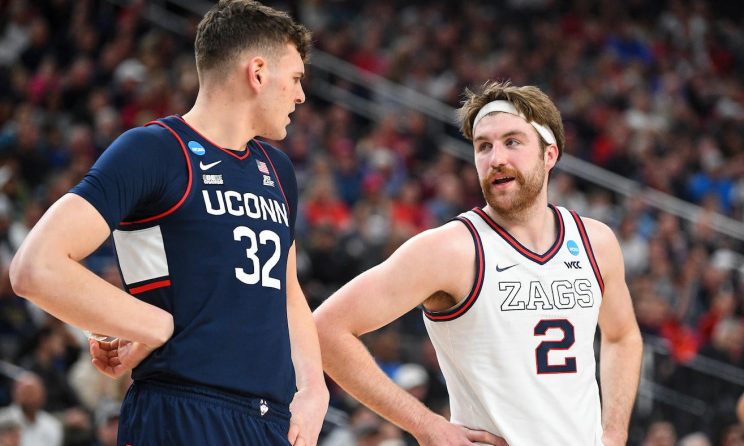
For months there’s been suspense in college basketball regarding two of its biggest programs on opposite ends of the country. Would Connecticut and/or Gonzaga ultimately abandon their basketball-first leagues for the Big 12? Was the Big 12 even that keen on adding the Huskies or Bulldogs?
To whatever extent, that push came primarily because Big 12 commissioner Brett Yormark was advocating to make the strongest hoops league in college sports even stronger by bringing the two aboard. For all of the millions of dollars that football brings in, Yormark, who has longstanding business ties in the Northeast, understands basketball’s global appeal and sees immense value and long-term growth potential in the Big 12 adding two prominent basketball schools.
“For Yormark, it is an international play,” a conference commissioner recently told CBS Sports. “I get why he’s doing it, I get his vision for it.”
But that courtship is dead, at least for the next couple of years. The Big 12’s raid on the decaying Pac-12 (Arizona, Arizona State, Colorado and Utah will all join next year) inflated the Big 12 to 16 schools. That’s quite the supplemental boost, and so that’ll be all for now. Big 12 presidents and athletic directors — many of whom were against adding Gonzaga or UConn from the start, sources said — are happy to be done and won’t be pushing to match the Big Ten’s tonnage of 18 programs.
Yormark confirmed as much this week.
“Right now we’re done,” Yormark told the Arizona Republic. “We had a vision. We had a strategy and effectively we’ve been able to execute it. Initially, I wasn’t sure if we’d go to 14 or 16. I think 16 was kind of a dream scenario, candidly. So from our perspective, our focus now is to integrate the four incoming schools as quickly as we can.”
Yormark specifically addressed Gonzaga and UConn during an appearance on the Marchand and Ourand Sports Media Podcast.
Either one of those schools, let alone both, leaving for the Big 12 would have amounted to a serious (and damaging) shakeup in the basketball landscape. But I’d argue it wouldn’t have made things better for either program in the long run. In fact, UConn and Gonzaga being left out of the Big 12 picture is likely the best outcome for both, but for different reasons.
Here’s why.
UConn
One major realignment lesson from the past 10-20 years is this: Know who you are, what you’re good at, what made you that way and why that matters in the big picture. Fans of Boston College, Nebraska, Miami, Maryland, Rutgers and plenty more aren’t having their day-to-day lives improved by the fact that those schools are making more money annually because of television deals. In fact, their experiences have for the most part been less enjoyable since their schools hopped conferences in chase of money.
Fans want their teams to be good, to play familiar opponents in games that matter and ultimately find their schools in position to contend for postseason glory.
UConn had it for a generation, lost it briefly when it left for the American Athletic Conference and was given a lifeline by the Big East. Now it sits atop the basketball world once more.
Bona fide basketball blue bloods, the reigning national champion Huskies have more NCAA titles in men’s basketball (five) than any program in the past 30 years. Beyond that, UConn’s five tournament trophies match Duke for the most of any school in the past 50 seasons of men’s college basketball. Unlike Duke, UConn did it with three coaches. The Big East helped make that possible.
Connecticut coach Dan Hurley said it earlier this year at the Final Four: “The Big East has been unbelievable for UConn. It’s a great partnership. I think we’re great for every team in the league. I think having big-brand programs that are playing at a high level, it only enhances everyone’s opportunity in the league.”
Of course, there is also the women’s program, which still has a claim to being the best in its sport thanks to 11 national championships. Leaving for the Big 12 would have brought some intrigue and made that league an outright basketball behemoth, but also would have a) undeniably made it more difficult on the men’s side to win league championships, b) complicated the path to reliably/consistently earn quality seeds in the NCAA Tournament, and c) potentially hampered its territorial dominance in the Northeast.
The slope would have gotten steeper. In the Big 12, UConn would’ve lost more games, logged thousands of miles more in travel, millions more in expenses and paid an untold tax on student-athletes’ overall well-being. Plus, precious annual rivalries in the Northeast would have ended — not to mention abandoning UConn’s direct attachment to Madison Square Garden and the Big East Tournament. Which isn’t to say UConn would have 100% left for the Big 12 if offered, but sources indicated that it was way more likely than not to leave had the all-sports invite ever been put on the table.
Had it been given the chance to leave in the next two years, UConn would have been on the hook for at least $30 million in exit fees, per its contract with the Big East.
Remember, UConn went hat-in-hand to the Big East more than four years ago and pleaded to be allowed back into a league it abandoned in 2013 on account of letting football drive the bus. That 2013 pivot to the American was a mistake. For years, UConn has embraced the “Basketball Capital of the World” slogan bestowed upon it. It only feels right that a school putting basketball first remains in a league that has identical philosophies.
UConn has 16 combined NCAA championships in women’s and men’s basketball.
Getty Images
Despite losing three underclassmen in one offseason to the NBA — something that hasn’t happened for UConn since the days of Jim Calhoun — the Huskies are poised to enter the season as a top-10 team. This feels right. UConn belongs in the Big East. There’s a lot to be said (and won) for knowing your identity and leaning all the way into it.
“The Big East was the best conference in the country this year,” Hurley said in April. “We were the most successful in the NCAA Tournament, and we have the national championship. So we were the best league in the country this year. And I don’t think that’s going to change. With the type of coaches that now have moved around, I don’t think we’re going anywhere. I know we’re not.”
Sure, a Big 12 invite would have brought the potential for millions and millions and millions more for the athletic department. That money would be huge — and most of it would have gone to overhauling a football program that has almost never moved the needle in New England, let alone nationally.
“Even if UConn was able to spend the money needed to get facilities on par in the Big 12, they would never have the NIL (money) for it,” one high-ranking power-conference source told CBS Sports. “People are not married to UConn football competing at this great level.”
Here’s the caveat: The Big East’s powers-that-be know that just because the Big 12 is occupied for now, that doesn’t mean the UConn matter is truly done-done. After a few years of running a 16-team conference, if Yormark is happy staying on as commissioner of the Big 12, there is a chance he’ll circle back with his presidents and push once more for basketball schools. Beyond that, of course UConn is monitoring the odd situation in the ACC, wherein Florida State has blasted out its unhappiness with its standing in that league. Should the ACC lose a school or two or four in the next stage of realignment, there is a chance that league could come calling for UConn.
Even if that were to happen, the ACC makes more sense than the Big 12.
Gonzaga
Gonzaga has been considering a maneuver out of the WCC for years. Like UConn, the Zags joining the Big 12 would have ensured the losses piled up much more frequently — but it would have brought GU to national television much more frequently as well. It’s in a different spot, as an institution, than Connecticut. Gonzaga was willing to trade in 30-win seasons for a chance to play schools that matter in January and February, with approximately 25 (or more) of their games on major linear TV.
In light of the Big 12 moving on (for now), one source described Gonzaga’s predicament as “a rolling situation.” Zags coach Mark Few has been as active and vocal behind the scenes in realignment plotting for his school as any head coach in the industry. However, it’s his president, Thayne McCulloh, who is guiding the Gonzaga ship.
Because the WCC has been a three-bid-at-best league for as long as Gonzaga has been a national power, Few needs to play the best teams he can as often as he can. Gonzaga has, in many ways, outgrown its conference while also thriving off its one-of-a-kind position in college basketball. The Big 12 would have given Gonzaga great opportunities while also inevitably knocking the school down a peg or two.
That in mind, there’s a pathway for a better future.
With the Big 12 off the table, Gonzaga still has options. Stay in the WCC? That’s a sensible one, according to many people I spoke with in recent weeks, even if things are somewhat uncertain. The WCC lost BYU to the Big 12, a major blow because it weakened the conference’s basketball profile. WCC presidents are not content to stay at nine teams and are in the process of examining which schools could be realistic targets to bring aboard to expand to 10, 11 or 12, sources said.
Can any additions appease Gonzaga? The Bulldogs are able to schedule in the nonconference as ambitiously as anyone in the sport — and they have to. Playing those games and earning wins against top-25 competition in November and December is a major factor in Gonzaga consistently finding itself seeded with a 1, 2 or 3 next to its name on Selection Sunday.
BYU leaving means two quality games are moving off the schedule in January/February — and potentially a third in the WCC Tournament. Few is not content to let Gonzaga stay in the WCC and have its standing in the sport drift a bit. In the short-term, staying in the WCC still gives Gonzaga latitude to keep on as a top-10 outfit in men’s college basketball. Long-term? Maybe not.
Mark Few has solidified Gonzaga as a top-10 program thanks to its outstanding non-conference record in the past decade.
Getty Images
If Gonzaga were to eventually move, it’s going to wait and see what materializes with the remnants of the Pac-12 and how that does or does not impact matters in the Mountain West. That could be the win here. Whatever form those leagues take in the weeks/months to come, they’re positioned to be better all-around in basketball than the WCC. And yet the entry point would still be tempting enough to allow Gonzaga to come in and easily be the best basketball program in those leagues.
The Mountain West pushed hard to get Gonzaga to join five years ago, only for GU to say no and leverage that opportunity for scheduling benefits and a bigger share of the pie in its media rights deal in the WCC. In that regard, Gonzaga is sitting pretty in the WCC. It dictates a lot of what happens in that league, and with good reason: Gonzaga is the cash cow and has been for close to two decades now. Because of the way the money is tiered due to NCAA Tournament performance, Gonzaga is making millions more than other schools in the league because of how well it’s fared in March Madness. If Gonzaga left for another league, it would leave millions on the table because that money would not go with them, per its agreement with the WCC.
The question becomes: Can Gonzaga maintain its status and standing to make more money by switching leagues? That’s what McCulloh and the power players at Gonzaga have been mulling.
Amid this, there have been some in the Mountain West who have still pushed for Gonzaga in recent times, even after the failed attempt to bring the Bulldogs aboard in 2018. Thickening the plot: Mountain West commissioner Gloria Nevarez was appointed to her post in November 2022, having been plucked as commissioner of the WCC.
“The Mountain West feels like they’d be the best league, better league, geographic profile fits, and in other sports too,” one high-ranking source said. “The finances are the big things. They get to keep so much more money at Gonzaga with the WCC setup. How much would they have to give up? They want the moon, but it would still have to make sense for the Mountain West.”
Same for the Pac-12, if it manages to continue in an inferior existence. The Pac-12 long looked down at Gonzaga, which does not have football, and now finds itself in a spot where it desperately needs GU to bolster its basketball profile and overall conference appeal. If Cal, Stanford, Oregon State and Washington State can stay on and recruit teams from the AAC, or merge with the Mountain West, Gonzaga would easily claim to be king in basketball. And it could potentially make more money. There’s a lot of temptation there. Lawyers still have to hash out a lot of this, but tens of millions are contracted to come in over the next six years for the “Pac-12” based on NCAA Tournament units won by the programs in that league.
“The Pac-12 still has the best resources in that they still have the NCAA unit shares that the league owns. The Pac-12 Network sucks, but it’s still an asset,” an industry source said.
Then there is the Big East, but sources said those talks between the league and Gonzaga have been on ice for a long time. It doesn’t sound like an outright invitation will come to fruition, and it’s purely because of geography.
“Gonzaga went radio-silent on the Big East,” a source said. “The geography is such a hard hump to get over for the student-athlete experience.”
If Gonzaga was located in the Midwest, it would have joined the Big East a decade ago. As I wrote in 2022, Gonzaga could look for some sort of scheduling alliance with the Big East and/or other leagues if it really wants to think outside of the box while staying in the WCC. Playing three or four games spread out over the season and all over the country (doable because the Big East has 11 teams, so one team is always off) is a creative workaround, and one I’m told the Big East would be receptive to discussing.
Now, a significant factor for Gonzaga is to maintain an outrageous level of winning/relevance in order to keep its appeal to other leagues. What Few has pulled off in the top left corner of the country is unique, historic, unprecedented. The Bulldogs have finished as a top-10 team in traditional polls and advanced metrics for seven straight seasons, and eight of the past nine. GU hasn’t been outside the top 25 at KenPom since the 2010-11 season. It last missed the NCAA Tournament in 1998.
So long as the standard keeps getting met, Gonzaga will continue to have options. Missing out on the Big 12 isn’t a bad thing for Gonzaga; it could position the school for a more fruitful future in basketball after Few retires, whenever that day comes.
And if nothing happens for the remainder of this decade?
“When the Big 12’s rights are up in 2030-31 and Yormark can look to separate basketball and football, hell yes, they will go after Gonzaga and other basketball-only schools,” one commissioner told CBS Sports.
Realignment never really ends. It has defined college sports for more than 100 years and will continue to do so. Gonzaga and UConn are defined by their basketball, and it’s for that very reason they were nudged off by the Big 12 — and likely for the better. Colorado and Washington and Arizona State and others will be making more money, but they won’t matter or be talked about or get publicity the way Gonzaga and UConn do. You can’t put a price on that and it won’t make as much money, but you can bank on the experience being a lot better.
Shouldn’t that be the point of all this?
Correction: An earlier version of this story stated UConn self-appointed its slogan as the “Basketball Capital of the World,” but similar wording was first used by Dick Vitale on a UConn men’s basketball broadcast in 1995.






